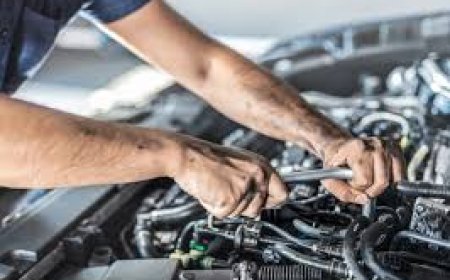Recycling on Four Wheels: The Sustainability Science Behind Car Dismantling
Explore how Scrap Car Yard Townsville supports the environment through proper car dismantling and recycling. Learn the science behind a greener car disposal method.

When a car reaches the end of its life, it can either become a burden to the environment or serve as a source of useful materials. Car dismantling is the process that turns this problem into a solution. Instead of letting old vehicles rot and leak into the earth, careful dismantling helps recover metals, plastics, rubber, and other parts that can be reused or recycled.
The science behind car dismantling is not only practical but also supports long-term environmental goals. It helps reduce landfill waste, lowers the demand for raw materials, and prevents toxic substances from entering soil and water systems. In Australia, where vehicle numbers continue to grow, this method offers a meaningful way to deal with the waste that comes from older cars.https://northcoastwreckers.com.au/
What Is Car Dismantling?
Car dismantling involves taking apart a vehicle to separate its parts and materials. The process begins with removing hazardous substances such as battery acid, coolant, brake fluid, and engine oil. These materials need special handling to prevent pollution. Once fluids are safely removed, workers begin to take out items that are still in good shape, like tyres, radiators, mirrors, and sometimes even the engine or gearbox.
Parts that can be reused are set aside. Others are sorted by materialmetals, plastics, rubberand sent for recycling. What remains is mostly the car shell, which is also broken down and reused where possible.
Reducing Landfill Waste
One of the biggest environmental problems today is the overflow of landfills. Cars, when dumped or left unused, take up a large amount of space. They contain materials that do not break down easily, such as plastic and rubber. Dismantling allows these parts to be removed and reused or reprocessed. It prevents the vehicle from ending up whole in a landfill where it would sit for decades without breaking down properly.
According to the Federal Department of the Environment, dismantling and recycling old vehicles can reduce waste by over 70 percent when done correctly.
Cutting Back on Resource Mining
The production of new cars depends on raw materials like iron, aluminium, copper, and rubber. Extracting these materials from the earth often involves energy-heavy mining that harms natural habitats and contributes to pollution. By recycling metals and other materials from dismantled cars, the need for new mining operations drops.
Reusing steel from old cars can save up to 74 percent of the energy required to produce it from raw ore. These energy savings also lower carbon emissions, helping the country move closer to climate targets.
Handling Toxic Materials
Old vehicles contain substances that can be dangerous if not handled correctly. Batteries have lead and acid. Fuel systems may still contain petrol or diesel. Air conditioning systems use gases that harm the ozone layer if released into the air. Brake pads can contain asbestos in older models.
Car dismantling includes the careful removal of these materials. Special containers are used to store and transport fluids and chemicals. This helps prevent spills that would otherwise soak into the soil or wash into drains and waterways. Safe handling also reduces risks to people working around the car.
The Role of Steel and Aluminium Recycling
Most of the weight of a car comes from its metal frame. Steel and aluminium make up a large portion of the body and engine. Recycling these metals is one of the most important parts of the car dismantling process. Steel is often melted and reused in buildings, tools, and even in making new cars.
Aluminium, though lighter than steel, is just as valuable. Recycled aluminium requires only 5 percent of the energy needed to create new aluminium from ore. This massive energy saving also cuts down on emissions and fuel use.
Local Action, Bigger Results
The positive impact of car dismantling is not only seen in global numbers but also within local communities. A Scrap Car Yard Townsville is one example of how this process works on a local scale. These yards are equipped to manage end-of-life vehicles, remove parts correctly, and handle toxic fluids with care. By following strict guidelines, they help prevent environmental damage in and around Townsville. Services like this also create jobs and keep materials in circulation, rather than letting them go to waste.
Making Room for Change
Australia has millions of registered vehicles. As cars get older, many are taken off the roads each year. If not dealt with properly, they sit unused and begin to fall apart. This can lead to soil contamination, unsafe properties, and fire hazards. Car dismantling turns this risk into something useful. It clears up space, removes harmful materials, and brings parts back into the cycle.
The process also allows old cars to serve one final purpose. Their metals and plastics go back into new products. Their working parts help other vehicles stay on the road longer. Their fluids are kept away from drains and waterways.
Looking Forward
The science behind car dismantling is based on careful steps that focus on safety, recycling, and resource use. As climate change and waste pollution continue to grow, taking action at the local level becomes more important. Scrapping cars the right way, through trained workers and well-run yards, helps create a cleaner path forward.
By understanding how dismantling works and why it matters, more people can take part in this shift. It is not only about getting rid of an old carit is about making a better choice for the environment.
Final Words
Every car that is scrapped through proper dismantling helps cut waste, save energy, and reduce harm to the planet. What was once a polluter on four wheels can become a part of a larger solution. Through careful removal of parts and proper recycling, car dismantling supports both people and nature.
It is a step that starts with one car, but its effect reaches far beyond the garage or scrap yard.



























































